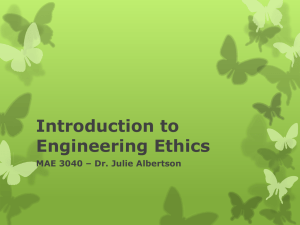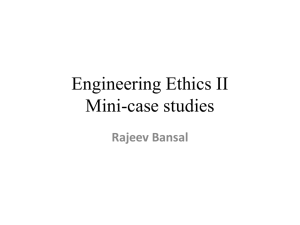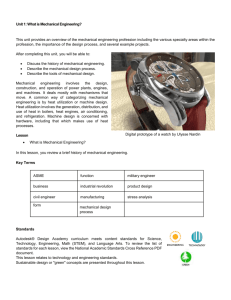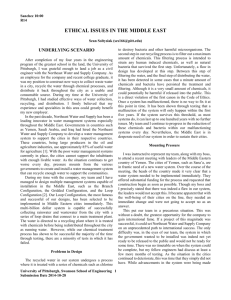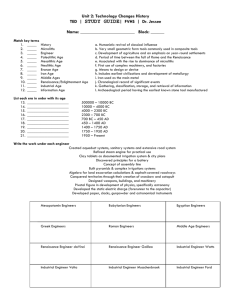the ethics of industrial espionage
advertisement
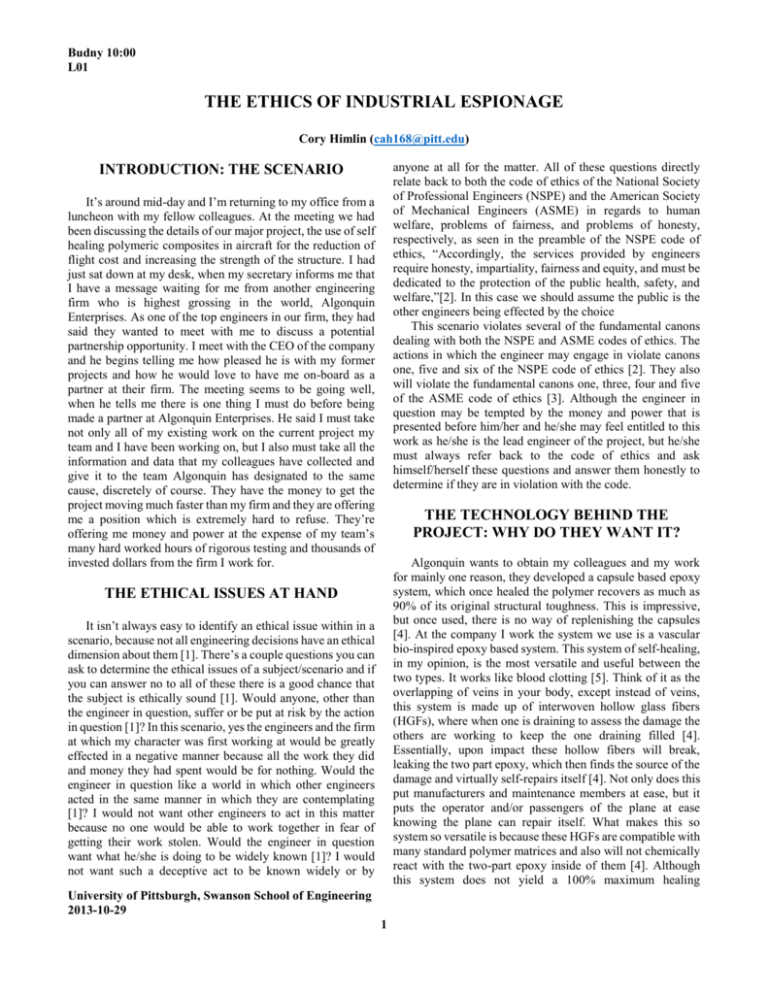
Budny 10:00 L01 THE ETHICS OF INDUSTRIAL ESPIONAGE Cory Himlin (cah168@pitt.edu) anyone at all for the matter. All of these questions directly relate back to both the code of ethics of the National Society of Professional Engineers (NSPE) and the American Society of Mechanical Engineers (ASME) in regards to human welfare, problems of fairness, and problems of honesty, respectively, as seen in the preamble of the NSPE code of ethics, “Accordingly, the services provided by engineers require honesty, impartiality, fairness and equity, and must be dedicated to the protection of the public health, safety, and welfare,”[2]. In this case we should assume the public is the other engineers being effected by the choice This scenario violates several of the fundamental canons dealing with both the NSPE and ASME codes of ethics. The actions in which the engineer may engage in violate canons one, five and six of the NSPE code of ethics [2]. They also will violate the fundamental canons one, three, four and five of the ASME code of ethics [3]. Although the engineer in question may be tempted by the money and power that is presented before him/her and he/she may feel entitled to this work as he/she is the lead engineer of the project, but he/she must always refer back to the code of ethics and ask himself/herself these questions and answer them honestly to determine if they are in violation with the code. INTRODUCTION: THE SCENARIO It’s around mid-day and I’m returning to my office from a luncheon with my fellow colleagues. At the meeting we had been discussing the details of our major project, the use of self healing polymeric composites in aircraft for the reduction of flight cost and increasing the strength of the structure. I had just sat down at my desk, when my secretary informs me that I have a message waiting for me from another engineering firm who is highest grossing in the world, Algonquin Enterprises. As one of the top engineers in our firm, they had said they wanted to meet with me to discuss a potential partnership opportunity. I meet with the CEO of the company and he begins telling me how pleased he is with my former projects and how he would love to have me on-board as a partner at their firm. The meeting seems to be going well, when he tells me there is one thing I must do before being made a partner at Algonquin Enterprises. He said I must take not only all of my existing work on the current project my team and I have been working on, but I also must take all the information and data that my colleagues have collected and give it to the team Algonquin has designated to the same cause, discretely of course. They have the money to get the project moving much faster than my firm and they are offering me a position which is extremely hard to refuse. They’re offering me money and power at the expense of my team’s many hard worked hours of rigorous testing and thousands of invested dollars from the firm I work for. THE TECHNOLOGY BEHIND THE PROJECT: WHY DO THEY WANT IT? Algonquin wants to obtain my colleagues and my work for mainly one reason, they developed a capsule based epoxy system, which once healed the polymer recovers as much as 90% of its original structural toughness. This is impressive, but once used, there is no way of replenishing the capsules [4]. At the company I work the system we use is a vascular bio-inspired epoxy based system. This system of self-healing, in my opinion, is the most versatile and useful between the two types. It works like blood clotting [5]. Think of it as the overlapping of veins in your body, except instead of veins, this system is made up of interwoven hollow glass fibers (HGFs), where when one is draining to assess the damage the others are working to keep the one draining filled [4]. Essentially, upon impact these hollow fibers will break, leaking the two part epoxy, which then finds the source of the damage and virtually self-repairs itself [4]. Not only does this put manufacturers and maintenance members at ease, but it puts the operator and/or passengers of the plane at ease knowing the plane can repair itself. What makes this so system so versatile is because these HGFs are compatible with many standard polymer matrices and also will not chemically react with the two-part epoxy inside of them [4]. Although this system does not yield a 100% maximum healing THE ETHICAL ISSUES AT HAND It isn’t always easy to identify an ethical issue within in a scenario, because not all engineering decisions have an ethical dimension about them [1]. There’s a couple questions you can ask to determine the ethical issues of a subject/scenario and if you can answer no to all of these there is a good chance that the subject is ethically sound [1]. Would anyone, other than the engineer in question, suffer or be put at risk by the action in question [1]? In this scenario, yes the engineers and the firm at which my character was first working at would be greatly effected in a negative manner because all the work they did and money they had spent would be for nothing. Would the engineer in question like a world in which other engineers acted in the same manner in which they are contemplating [1]? I would not want other engineers to act in this matter because no one would be able to work together in fear of getting their work stolen. Would the engineer in question want what he/she is doing to be widely known [1]? I would not want such a deceptive act to be known widely or by University of Pittsburgh, Swanson School of Engineering 2013-10-29 1 Cory Himlin on the project. They aren’t requesting consent from their employer to do so. Canon five states that engineers in the carrying out of their professional duties shall avoid deceptive acts. Subsection B of this canon reads, “Engineers shall not offer, give, solicit, or receive, either directly or indirectly, any contribution to influence the award of a contract by public authority, or which may be reasonably construed by the public having as having the effect or intent of influencing the awarding of a contract. They shall not offer any gift or other valuable consideration in order to secure work. They shall not pay a commission, percentage, or brokerage fee in order to secure work, except to a bona fide employee or a bona fide established commercial or marketing agencies retained by them,”[2]. In this instance, Algonquin is trying to persuade the engineer with a high position in there company which also comes along with a much larger salary. They are the ones in violation of this code, and the engineer would also be in violation of this had he/she accepted the position. Canon six states that engineers shall conduct themselves honorably, responsibly, ethically, and lawfully so as to enhance the honor reputation and usefulness of the profession [2]. If the engineer in question took part in this scheme to take the work and give it to the other company then they wouldn’t be acting honorably, ethically, responsibly, and depending if the work was patented or not then they may also be acting in an unlawful manner. Both parties would be in violation of this canon in the case that the engineer in the scenario accepts the offer. efficiency rate, it does hold a 80-90% efficiency rate [5] which we as engineers are hoping to improve in due time and with the right financial support and community backing. Not only does this system promote safety, but the use of the materials would also reduce both fuel needs and carbon emissions of airplanes helping the economy and environment [5]. Capsule based self-healing methods yield better results, but the aircraft companies don’t want something they could use only one time. In this system the healing compound is cloistered in miniscule capsules until damage occurs and ruptures these capsules releasing the agent to fix the problem [4]. This is ideally the easiest system to implement [6], but once the microcapsule has been ruptured and emptied, it’s gone, and Algonquin does not want to waste the time and money to fix this problem, so they want to fix it through obtaining my researchers’ work. In fact, the reason they started making the capsule system is because they obtained a researcher from the University of Illinois at UrbanaChampaign who has previously helped develop self-healing materials to address a micro-cracking problem in structures [7]. In this process, the researcher helped created microcapsules which are filled with a resin matrix infused with a monomer [7]. When a crack is formed in the composite material, these microcapsules break, releasing the monomer which then finds the source of the damage and polymerization occurs thus initiating the healing process [7]. I find this very impressive, because not only is it healing the damage that occurs, but the epoxy based resin is also “smart” enough to find the source of the damage, but again, they do not want to use this process because the capsules will not replenish themselves. With a growing market in composites and a growing availability in the technology [8] and an estimated market worth of $41.8 billion over the next 10 years [9] no wonder they want to have the leading product. APPLYING THE CODE OF ETHICS: ASME Engineers should not only see themselves as merely employees of large organizations, but as independent practitioners with a culture and a set of practices all their own [10]. And not only will he/she violate the canons in the NSPE code of ethics, but they would also be violating the code of ethics of their own specific profession, mechanical engineering, specifically canons one, three, four and five. Canon one of the ASME code of ethics also states that engineers shall hold paramount the safety, health and welfare of the public in the performance of special duties [3]. As stated before this engineer will be in clear violation of this canon if they take part in the action. In fact people might also see these actions as industrial espionage [11] which would completely ruin the reputation of the engineer and the company the engineer is discretely obtaining this information and work for. Canon three states that engineers shall continue their professional development throughout their careers and shall provide opportunities for the professional and ethical development of those engineers under their supervision [3]. Well, if the engineer in this scenario takes part in this secretive action then they are clearly violating this canon because they are taking away from the engineers below them and putting APPLYING THE CODE OF ETHICS: NSPE The scenario violates canons one, five and six of the NSPE code of ethics. Canon one states that engineers in the carrying out of their professional duties shall hold predominantly the safety, health, and welfare of the public [2]. This is very important because in this case, the public addressed in this situation would be that of the colleagues of the engineer and the engineers company (i.e. boss, investors, etc.). Furthermore, subsection C of canon one states, “Engineers shall not reveal facts, data, or information without the prior consent of the client or employer except as authorized or required by law or this Code,”[2]. This clearly violates that because Algonquin Enterprises is asking the engineer of the other company to divulge the work and information of their project in a discrete manner so as they can get the upper hand 2 Cory Himlin them in a very unethical situation which may change their view on how the world of engineering really works. The engineers might begin to think that everyone is out for one another and begin to act in the same manner, trying to gain the advantage for themselves and not for the greater good of the engineering community. Taking part in this scenario and accepting Algonquin’s offer would not set a very good example for the engineers underneath the lead engineer. Canons four and five of the ASME code of ethics go hand in hand. Canon four states that engineers shall act in professional matters for each employer or client as faithful agents or trustees, and shall avoid conflicts of interest [3]. Canon five states that engineers shall build their professional reputation on the merit of their services and shall not compete unfairly others [3]. By using canon four as a guide engineers would also be following canon five by building their professional reputation based on their merit and also they would not be competing unfairly with other companies and/or engineers. If the engineer in question took part in the act of giving information to the other company they would be violating canon four thus violating canon five as well. They would not be acting faithfully towards their company nor would they be acting professionally so they would not be building their professional reputation and career based on merit, but more or less on deception and selfishness. They would also be competing unfairly with the original company because they would be stealing the work of their colleagues and giving it to the company that has more money to progress faster in the study. REFERENCES [1] H.C. Luegenbiehl, M. Davis. (1987). “Engineering Codes of Ethics: Analysis and Applications.” NSPE. (Online Article). http://ethics.iit.edu/publication/CODE-Exxon%20Module.pdf [2] (2007). “Code of Ethics for Engineers.” NSPE. (Online Article). http://www.nspe.org/Ethics/CodeofEthics/index.html [3] (2003). “Code of Ethics for Engineers.” ASME. (Online Aricle). https://www.asme.org/getmedia/9EB36017-FA98477E-8A73-77B04B36D410/P157_Ethics.aspx [4] B. Blaiszik, S. Kramer, S. Olugebefola, J. Moore, N. Sottos, S. White. (2010). “Self-Healing Polymers and Composites.” Annual Review of Material Research. (Online Article). http://www.annualreviews.org/doi/pdf/10.1146/annurevmatsci-070909-104532 [5] B. Nelson. (2010). “Airplanes of the future could be selfhealing.” MSNBC. (Online Article). http://www.nbcnews.com/id/25098805/ns/technology_and_s cience-innovation/t/airplanes-future-could-be-self-healing/ [6] T. Hume. (2013). “Heal thyself: The ‘bio-inspired’ materials that self-repair.” CNN. (Online Article). http://www.cnn.com/2013/02/22/tech/self-healingmaterials/index.html [7] OTM Team. (2012). “Polymeric Self-healing Composites for Longer Lasting Products.” University of Illinois. (Online Article). http://otm.uic.edu/technologies/polymeric-selfhealing-composites-longer-lasting-p [8] F. Smith. (2013). “The Use of Composites in Aerospace: Past, present, and future challenges.” Avalon Consultancy Services LTD. (Online Blog Entry). http://avaloncsl.files.wordpress.com/2013/01/avalon-theuse-of-composites-in-aerospace-s.pdf [9] N. Hampson. (2011). “Gaining Technological Advantage: A&D Insights.” Aerospace and Defence. (Online Article). http://www.pwc.com/en_IM/IM/publications/assets/shipping -aircraft-space/aerospace-defence-insights.pdf [10] C. Reader. (2012). “The Importance of Engineering Ethics.” eHow. (Online Article). http://www.ehow.com/print/info_8347158_importanceethics-engineering.html [11] T. Ellis-Christensen. (2013). “What is Industrial Espionage.” wiseGEEK. (Online Article). http://www.wisegeek.com/what-is-industrial-espionage.htm CONCLUSION: THE FINAL DECISION In this situation, I believe the decision is pretty clear-cut. The engineer should not take the offer that Algonquin has offered. Referencing back to the code of ethics, you can see many canons the engineer will violate if he/she takes the position in which they were offered. It may have been a more difficult decision had the scenario effected the public in a very positive way but the only thing is truly effects in a positive manner is the engineer taking the offer. This engineer would be most likely shunned by all other companies if the situation goes public, which it most likely will. Using the code of ethics to guide me through this scenario, I believe it would be a very poor, unethical, and unprofessional decision to take the offer. ACKNOWLEDGEMENTS I would like to that the time to thank my roommate, Matthew Labashosky, for helping me through this paper by listening to me read my paragraphs over and over again. I would also like to thank Katy Rank Lev for taking the time to adequately and fairly grade my paper. 3
